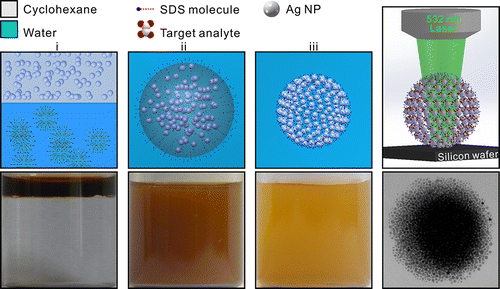Drug abuse has currently raised worldwide concerns of public security. Particularly, amphetamines including methamphetamine (MA) and 3,4-methylenedioxy-methamphetamine (MDMA) are the most commonly used synthetic drugs. Rapid component separationand robust SERS identification of drugs in real human urine remain an attractive challenge because of the sample complexity, low molecular affinity for metal surface, and inefficient use of hotspots. A rapid SERS platform for detecting drugs in real human urine seriously depends on three key problems: (1) the strategy to rapidly separate and collect the drugs in human urine; (2) the prevention of interference due to the complicated composition of the urine; (3) the robust control over drug molecules in the hotspot region of SERS-active nanostructures.
An important progress on rapid component separation and detection of drugs in real human urines by surface-enhanced Raman scattering (SERS) was achieved by Prof. Liang-Bao Yang and Hong-Lin Liu from Nano-materials & Environmental Detection Laboratory. The result has been published in “Analytical Chemistry” (Anal. Chem. 2015, 87: 4821–4828), and Zhenzhen Han is the first author of this article.
A 5 min strategy of cyclohexane (CYH) extraction for separating amphetamines from human urine was developed. Simultaneously, an oil-in-water emulsion method is used to assemble monodisperse Ag nanoparticles in the CYH phase into spherical colloidal superstructures in the aqueous phase. These superstructures create three-dimensional (3D) SERS hotspots which exist between every two adjacent particles in 3D space, break the traditional 2D limitation and extend the hotspots into the third dimension along the z-axis. In this platform, a conservative estimate of Raman enhancement factor is larger than 107, and the same CYH extraction processing results in a high acceptability and enrichment of drug molecules in 3D hotspots which demonstrates excellent stability and reproducibility and is suitable for the quantitative examination of amphetamines in both aqueous and organic phases. This SERS platform for the quantitative analysis of MA in both aqueous solution and real human urine has an excellent performance, of which the detection limits reach 1 and 10 ppb, respectively. Moreover, SERS examinations on different proportions of MA and MDMA in human urine demonstrate an excellent capability of multiplex quantification of ultratrace analytes. By virtue of a spectral classification algorithm, they realize the rapid and accurate recognition of weak Raman signals of amphetamines at trace levels and also clearly distinguish various proportions of multiplex components. The platform for detecting drugs promises to be a great prospect for a rapid, reliable, and on-spot analyzer.
This work was supported by the National Basic Research Program of China (2011CB933700), the National Instrumentation Program of China (2011YQ0301241001 and 2011YQ0301241101), National Natural Science Foundation of China (21305142), and et al.

The Article Link: http://pubs.acs.org/doi/full/10.1021/acs.analchem.5b00176